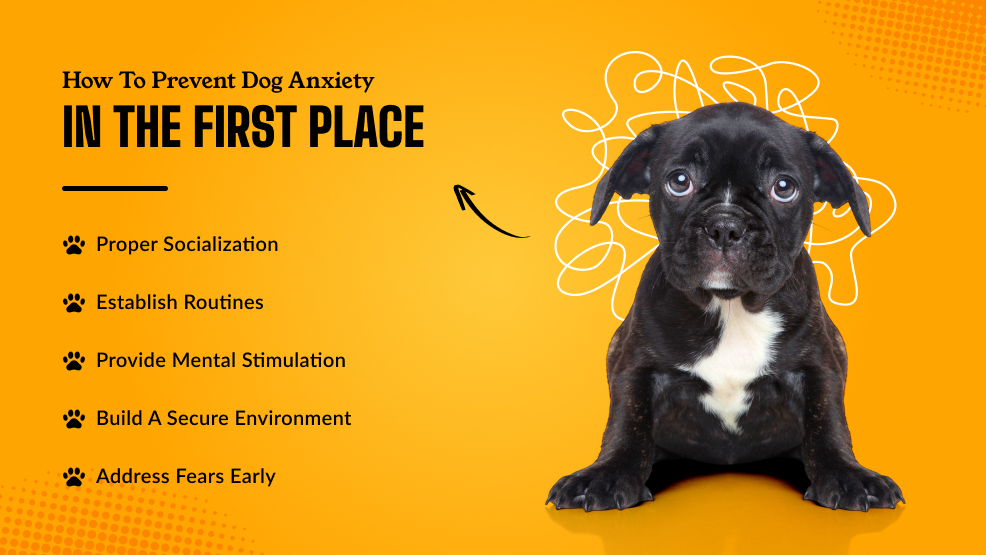Understanding Dog Anxiety: Causes, Symptoms, and Solutions


If you have been a dog parent for some time now, then you know that dog anxiety is a real and often misunderstood condition that affects many of our canine family members. This condition can manifest in various ways, from subtle behavioral changes to more pronounced physical symptoms.
Understanding the root causes of dog anxiety is the first step in helping your furry friend live a happier, more balanced life. In this comprehensive guide, we’ll explore the causes, symptoms, and effective strategies for managing and preventing anxiety in dogs.
Anxiety in Dogs: Signs and Symptoms

Anxiety in dogs can stem from a variety of factors, including genetics, past traumatic experiences, or environmental changes. Dogs can’t verbalize their feelings when they are stressed, but they communicate their anxiety through various behaviors.
It’s essential to recognize the signs of anxiety in your pup and address them promptly, as prolonged stress can lead to behavioral issues and even physical health problems.
Here are some common indicators of dog anxiety:
- Excessive barking or whining
- Panting or drooling (when not related to exercise or heat)
- Trembling or shaking
- Pacing or restlessness
- Destructive behaviors (chewing, digging, or scratching)
- Hiding or attempting to escape
- Loss of appetite or digestive issues
- Excessive licking or grooming
It’s important to note that some of these behaviors can also be signs of other underlying issues, so it’s always best to consult with your veterinarian if you notice any concerning changes in your dog’s behavior.
Common causes of dog anxiety
Dogs can experience anxiety for various reasons, and understanding the root cause is essential for addressing the issue effectively. Here are some common triggers of dog anxiety:
- Separation anxiety: Many dogs experience distress when left alone, leading to destructive behaviors or excessive vocalization.
- Fear of loud noises: Thunderstorms, fireworks, or even vacuum cleaners can trigger anxiety in some dogs.
- Past traumatic experiences: Neglect, abuse, or traumatic events can leave lasting emotional scars and contribute to anxiety.
- Changes in routine or environment: Dogs thrive on predictability, and sudden changes can be unsettling for them.
- Lack of socialization: Inadequate socialization during the critical puppy stage can lead to fear and anxiety in unfamiliar situations.
- Age-related cognitive decline: As dogs age, cognitive changes can contribute to increased anxiety and confusion.
Understanding the specific trigger(s) for your dog’s anxiety can help you develop targeted strategies for managing and alleviating their distress.
The Impact of Anxiety on a Dog’s Well-being

Anxiety is more than just an emotional state; it can have profound effects on a dog’s overall well-being. Chronic stress and anxiety can lead to various physical and behavioral issues, including:
- Weakened immune system and increased susceptibility to illness
- Digestive problems, such as vomiting or diarrhea
- Loss of appetite or weight loss
- Increased aggression or fear-based behaviors
- Self-mutilation or excessive grooming
- Decreased quality of life and enjoyment of activities
Addressing your dog’s anxiety is important not only for their emotional well-being but also for their overall health and happiness. By taking proactive steps to manage and reduce their anxiety, you can help ensure a better quality of life for your furry friend.
How to Help a Dog With Anxiety?

If you suspect your dog is experiencing anxiety, there are several strategies you can employ to help alleviate their distress. Here are some effective approaches:
Create a Safe Space
Designate a quiet, comfortable area for your dog to retreat to when feeling anxious. This can be a crate or a cozy corner with their favorite blanket and toys.
Provide Mental Stimulation
Engage your dog’s mind with puzzle toys, interactive games, or training sessions to help redirect their focus and reduce anxiety.
Exercise Regularly
Regular physical activity can help burn off excess energy and reduce stress levels in dogs.
Use Calming Aids
Consider using pheromone diffusers, calming supplements, or anxiety vests to help soothe your dog’s nerves.
Practice Desensitization and Counterconditioning
Gradually expose your dog to their triggers while pairing them with positive experiences and rewards to help them overcome their fears.
Seek Professional Help
If your dog’s anxiety is severe or unresponsive to your efforts, consult with a certified animal behaviorist or a veterinary behaviorist for specialized guidance.
Remember, managing dog anxiety is an ongoing process that requires patience, consistency, and a tailored approach based on your dog’s specific needs.
Natural Remedies for Dog Anxiety
In addition to behavioral interventions, there are several natural remedies that can help alleviate dog anxiety. Here are some options to consider:
- Pheromone products: Synthetic pheromones, such as Adaptil (Dog Appeasing Pheromone), can help promote a sense of calm and security in dogs.
- Calming supplements: Supplements containing ingredients like melatonin, L-tryptophan, or chamomile can have a calming effect on anxious dogs.
- Essential oils: Certain essential oils, like lavender or chamomile, are known for their soothing properties and can be diffused or applied topically (with caution).
- Herbal remedies: Herbs like valerian root, skullcap, or St. John’s wort have been used traditionally to promote relaxation and reduce anxiety in dogs.
- Massage and acupressure: Gentle massage or acupressure techniques can help release tension and promote relaxation in anxious dogs.
It’s important to consult with your veterinarian before introducing any new supplements or remedies to ensure they are safe and appropriate for your dog’s individual needs.
Training Techniques to Reduce Dog Anxiety

Training can be an effective way to help manage and reduce dog anxiety. Here are some training techniques that can be beneficial:
- Desensitization and counterconditioning: Gradually exposing your dog to their triggers while pairing them with positive experiences (like treats or praise) can help them overcome their fears.
- Relaxation training: Teaching your dog specific cues or commands to help them relax, such as “settle” or “mat,” can be a powerful tool for managing anxiety.
- Confidence building: Engaging your dog in positive reinforcement training and providing them with opportunities to succeed can help boost their confidence and reduce anxiety.
- Socialization: Exposing your dog to new environments, people, and situations in a controlled and positive manner can help them become more confident and less anxious in unfamiliar situations.
It’s important to approach training with patience, consistency, and positive reinforcement techniques. Working with a certified dog trainer or behaviorist can be beneficial, especially for more severe cases of anxiety.
When to Seek Professional Help for Dog Anxiety?
While many cases of dog anxiety can be managed with the strategies outlined above, there are instances when professional help may be necessary. Consider seeking guidance from a veterinary behaviorist or a certified animal behaviorist if:
- When your dog’s anxiety is severe or unresponsive to your efforts
- In case yur dog displays aggressive or self-injurious behaviors
- If your dog’s anxiety is impacting their quality of life or your ability to care for them
- You are unsure of the underlying cause of your dog’s anxiety
Professional help can provide specialized assessments, tailored treatment plans, and guidance on managing complex cases of dog anxiety.
How to Prevent Dog Anxiety in the First Place

While it’s not always possible to prevent dog anxiety entirely, there are steps you can take to minimize the risk and help your pup develop a resilient and confident mindset:
Proper Socialization
Exposing your puppy to various sights, sounds, and experiences in a positive and controlled manner can help them develop confidence and adaptability.
Establish Routines
Dogs thrive on predictability, so creating consistent routines for feeding, exercise, and playtime can help reduce stress and anxiety.
Provide Mental Stimulation
Engaging your dog’s mind with puzzle toys, training sessions, and interactive games can help prevent boredom and anxiety.
Build a Secure Environment
You should create a safe, comfortable space for your dog to retreat to when feeling anxious can help them feel secure and relaxed.
Address Fears Early
If you notice your dog displaying signs of fear or anxiety toward specific triggers, address them promptly with desensitization and counterconditioning techniques.
By taking a proactive approach to prevention, you can help set your dog up for success and minimize the risk of developing anxiety-related issues.
Support Your Anxious Dog So That They Lead A Happy Life
Dog anxiety is a complex and often misunderstood condition, but with the right strategies and support, it can be effectively managed. Remember, your furry friend’s well-being is the top priority, and addressing their anxiety is not only important for their emotional health but also for their overall quality of life.
By being attuned to the signs of anxiety, understanding the underlying causes, and implementing a multi-faceted approach that combines behavioral interventions, natural remedies, and professional guidance (when necessary), you can help your anxious dog find relief and live a happier, more balanced life.









Leave A Comment